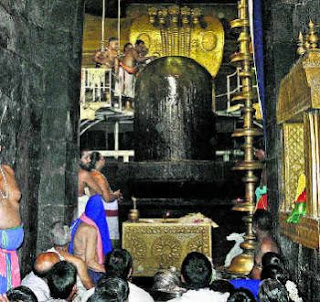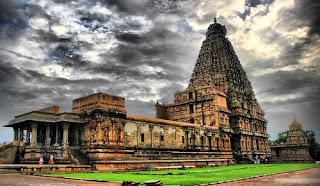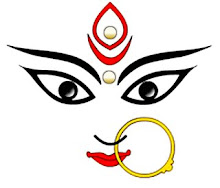A magnificent glory of Chola - The Big Temple, Thanjavur - India's Greatest Architectural Wonder!
The reason for this Post of mine is to let the world know of the Chola architetectural and engineering skills, the sculptural and painting marvels and of course the careful planning and execution involved to build such a huge, magnificent monument.
RajaRaja Chola the GreatRajaraja Chola I [ 985 to 1015 CE] was an unequalled monarch who ruled the entire Southern part of India over thousand years ago, whose greatness and glory can still witnessed by the world by his magnum opus the Brahadeswara Temple in Thanjavur.
I
ts not an exaggeration to call RajaRaja Chola an all round genius earning him the various titles which can be found in his inscriptions.
Rajaraja built the Great temple of Thanjavur and covered the two hundred feet high tower with gold to signal his contribution. The temple survives to this day in its original grandeur. It is a magnificient haven of architecture, sculpture and paintings.
Rajaraja was a staunch follower of Saivism but ensured religious tolerance and patronized all religions Saivism, Vaishnavism, Saktam, Jainism and Buddhism alike.
HistoryThe greatest of Chola emperors Rajaraja-I (985 A.D - 1012 A.D) the son of Sundara Chola (Parantakaa-II) and Vanavanmahadevi built this magnificent temple named Brihadisvaram at Thanjavur - the capital of Chola dynasty.
From the epigraphical evidence it is known about Rajaraja-I started building this temple on his 19th year and completed on 275th day of his 25th year. It took just 6 years to complete this work on 1010 A.D.
Rajaraja-I named this temple as Rajarajesvaram and the deity Shiva in Linga form as Peruvudaiyar, the temple is also known in the deity's name as Peruvudaiyarkovil [in Tamil language]. In later period Maratta and Nayaks rulers constructed various shrines and gopurams of the temple. In later period when the Sanskrit language was more popular during the Maratha rule the temple was named in Sanskrit as Brihadisvaram and the deity as Brihadisvara. Now-a-days it is called as Thanjai Periyakovil (Tanjore Big temple).
Keralaanthagan Gopuram
Rajaraja Chola assumed the title of Keralaanthakan meaning Destroyer of Kerala (Chera's). after his victory over Kerala king Baskararavivarma This gopuram is named after this title .
This is a five stage gopuram. In the front side of the gopuram one can see various forms of Shiva - Rudhrathandava pose (a fierce Shiva in dancing form), Shiva with Parvathi, Bichadanar (Shiva as beggar).
In the rear side of the gopuram one can see Krishna Leela, MahaVishnu in the first stage, Narasimha combating with Hiranyakasibu in one side and Hiranya Samkara on the other side. On the top stage Shiva and Vishnu idols are seen.
The Keralaanthakan gopuram is constructed on the same architectural concept of the Srivimana. Firstly, the load is distributed on two huge granite walls and the walls are merged into single structure as it approaches the height. Secondly, the Ball and Lock of the huge granites locks themselves with the neighboring rock, one can see the small projections evenly distributed on the base of the structure. Thirdly, the huge base platform distributes the load to the ground with the minimum foundation depth.
Rajarajan Gopuram
This gopuram is built by Rajaraja-I and depicts the mediaeval chola architecture where the Raja gopuram (the entrance gopuram) diminish in size and the Karpagraham (the main deity's gopuram) is significant.
The two huge 15 feet monolithic Dwarapalas on either side of this entrance is seen The 15 feet huge monolithic stone sculpture of the Dwarapala revals the Thattva (concept) that God is Everywhere as shown by the upper two hands and the pose of right hand index finger denotes that God is one and only one. On keen notice one can see a Elephant is being swallowed by a snake and the Lion standing behind. This denotes even if one faces such a big problem as of this magnitude a strong stand (a firm belief in God) similar to that of a Lion's strong standing posture will lead ways to realize God.
The temple is open daily. The sanctum sanctorum opens only during Pooja times. Please check with temple pooja timings.
Considering the technology of those ancient times, it is undoubtedly a marvel of engineering.
More on this Grand structure, as we celebrate a thousand years of the ‘Big Temple' in Thanjavur – Rajaraja Chola dedicated it to Brahadeeswara, Lord of the Universe in 1010 – an ode to the monument that has never ceased to amaze with its simple design, stupendous proportions and grandeur...
This “Big Temple” [Peria Kovil] in Thanjavur, is one thousand years old this year, 2010. Rajaraja Chola I commissioned this greatest edifice of Tamil history and performed the sacred dedication of the temple in the year 1010, the 25th year of his reign. It was the jewel-in-the-crown of Rajaraja, an extraordinarily powerful king, a grand monarch with a style of his own, a conqueror who also understood art and architecture, and a true devotee of Siva. It is a matter of pride that a Tamil king built the finest example of Tamil architecture, stupendous in proportion, yet simple in design. Siva in this temple is known as Brihadisvara — the Lord of the Universe. A gigantic stone “lingam” fills the sanctum sanctorum, sheltered by a vimanam (towering roof) which pierces the sky at 216 feet. One can gaze with awe at this majestic structure from a distance as one drives towards Thanjavur. However many times one has seen it, one cannot help but hold one's breath in amazement. And as you enter its precincts, this temple never fails to humble you, for, such is its magnificence. It is the perfect tribute to the Almighty, ordered by a great king and executed by his subjects who contributed to its building in more ways than one. To this day, it stands tall as a reminder of who we are in the history books of culture, art, architecture, religion, language, governance and trade.
The temple occupies an area measuring about 750 feet by 400 feet, in a fort, surrounded by a moat. It is a marvel of engineering, considering the technology of those ancient times. The towering vimanam is built up with stones with bonding and notching, without the use of mortar. The topmost stone, weighing about 80 tons, is still a matter of discussion for engineers who are baffled as to how the builders lifted it to that height without the help of modern contrivances. A charming tale is told about a ramp being built from a village — Sarapallam — four miles away, from where the giant stone was pulled up by elephants!
Representative of Craftsmanship
The Srivimanama, or tower over the main shrine, of the Brihadeswarar temple is 61 metres tall. Imagine that being built in 1002 CE. The foundations for it are only 2 metres deep - it is constructed in such a way that the weight of the Vimanam is evenly distributed on itself. It is hollow inside and layered to allow access for the intrepid.
The top the pyramid-shaped tower holds the Vimana - a monolithic huge rock spherical in shape, weighing approximately 81 tones. Above the Vimana the Kalasam made up of gold can just be seen - its height is 4m and it was originally presented by Rajaraja Chola 1.
On the flat roofed portions of the structure, you can see many Nandi statues. Each of the 16 or so layers of the tower contain intricate carvings. If you view this pic large (see link below), you can view some of them on the lower layers.
 |
| The Nandhi |
Figures of Dakshinamurthi, Nataraja in Thillai, surrounded by celestials, dancers and saints in a celebration, and Tripuranthaka, the gigantic warrior, are masterpieces of Chola painting. The story of Sundaramurthi Nayanar reaching Kailash on a white elephant is depicted on another wall.
The most telling of all is the portraiture of Raja Raja with his Guru Karuvur Devar. It was Karuvur Devar, the administrator, who master-minded the building of the temple, and fittingly he has a special shrine dedicated to him in the outer courtyard of the temple. While the sculptures of Shiva in this corridor are imposing and colossal, the fine series of 81 karanas (dance poses) are superb illustrations of the Natya Sastra. These figures are much bigger than the dance figures in Chidambaram and other temples.
Plenty of Documentation
The most exciting aspect of this temple is the vast number of inscriptions on its walls which record details of Raja Raja's reign as well as that of his successors.
They reveal that Raja Raja endowed a large number of villages, money and cattle to the temple for its maintenance, daily worship, festivals, singing of devotional songs and dancing. He and his queens presented fantastic gold and gem set jewels to the temple. The king's donations, as well as those of his favourite queen Lokamahadevi, and his sister Kundavai are recorded on a slab close to the sanctum. Among the most noteworthy inscriptions is the one about the two streets given over to the occupation of the 400 Devadasis who were pressed into the service of the temple from many surrounding temples of the region. Their names, places of origin, the door numbers of the houses they occupied are also part of the details inscribed. From the inscriptions we gather that the king, his queens, and their relatives set the example followed by the nobility, the merchants and even soldiers, to return to the people what was collected by taxes etc., by erecting irrigation canals, hospitals, schools, granaries etc.
One of the best bronze images of the period is that of Nataraja, referred to as “Adavallan” in this temple. Raja Raja named the currency of his reign, a coin, Adavallan.
Over time, many additions and improvements took place in this temple. Sevappa Nayak, the first of his dynasty who ruled Thanjavur, built the shrine for Murugan (Subrahamanya) as an integral part of the temple. It is a beautiful, elaborately-carved stone structure, a designer's delight. To copy the un-repeated designs on each of the short pillars of this shrine would take an artist weeks if not months. One can just imagine how long the stone chiseller would have taken to complete each piece. Facing this shrine one can also see a mandapam which houses a Maratha period portrait gallery. Done as mural paintings but in the style now known as “Tanjore painting” with gold leaf embossing, the portraits of Serfoji, his queen and other royals are a feast of colour.
One can spend a whole day in the Big Temple, and still want to come back to marvel at every detail of its beauty. Many kings had built temples to Shiva on the banks of the Kaveri. Many saints have sung in praise of these deities. But there is only one temple to Brahadeeswara, and it stands tall a thousand years after a devotee-king climbed a ladder with a copper pot [kalasam] anointed with holy water from all the sacred rivers, to dedicate it to our history. A stupendous marvel indeed!
The Architectural Beauty
Little is known as to who designed the Big Temple but it succeeds in projecting the grand imperial vision of a king who expanded the boundaries of the Chola empire.
In 1946, after Archaeological Survey of India (ASI) took charge of the conservation of Brahadeeswara temple at Thanjavur, conservationists noticed that the jambs and lintels of all the doorways in the tower were systematically damaged by gun fire [caused in the 19 century]. The intent behind this wanton destruction, the conservationists observed, “was perhaps to let the whole structure collapse by itself”.
None of that happened. Good design and sound structural logic served in good stead and for the last thousand years the structure has stood firm. The Brahadeeswara temple, completed in 1010 CE, for good reasons, is celebrated as a towering example of architectural excellence.
A monument was in order after Rajaraja I (985-1014), the Chola emperor, had vastly expanded the limits of the empire and brought immense wealth. It had to be ambitious and befit the imperial vision. By that time, temple architecture in South India had significantly advanced. The Pallavas of Kanchipuarm, in the 8th century, demonstrated how multilevel functional temples could be built. There were also examples of temples with more than three tiers. These structures offered a broad template, but it was clear to the architects of Rajaraja that the temple at Thanjavur should far exceed all of them.
Rajarajesvaram, as the temple complex was known in the inscriptions, when completed, was 40 times larger and five times taller than any average temple that preceded it and consumed 130,000 tons of granite. The 60-metre tall vimana[tower over the sanctum] built in 15 tiers, appeared like a huge mountain and remains the tallest in South India.
The unusually tall vimana alone weighed about 43,000 tons and supporting it was a challenge. Though the pyramidical shape of the vimana is self-stabilising, the architects could not afford to make the base appear wide and loose out on the visual appeal.
A proportionately large sanctum with double walls and circumambulatory passage in-between was designed. It rose to two tiers and merged at the third and held the tower.
Simultaneously, the vimana and the structures in front were consciously separated by a constriction in the elevation so that the tower could visually stand out.
Architectural studies show that a larger forecourt measuring 241 by 121 meters was specially designed to spatially hold the tower. The court was made of two equal square parts and the vimana was placed at the centre of the rear square. This provided the necessary foreground to view the elegance of the tower in full.
If the vimana was exceptional, the gopuras or gateways of this temple are milestones in architecture history. Rajarajesvaram was ‘the greatest single step forward' in the development of gopuras in South India. Their axial placement frames the view of the vimana impressively and visually anchors the visitor. Though many structures and shrines were added to Rajarajesvaram till 19th century, they have not fortunately cluttered the complex and the original design intent can still be appreciated.
What is not well known, despite abundant inscriptions, are the names of the architects who designed it and the methods of construction adopted.
It is popularly believed that a linear ramp stretching seven kilometres was built and stones were hauled to the top. Few others suggest that short ramps around the tower were constructed. There is no final word yet on this.
Popular Myths
A few of the myths, however, have been proved wrong. The cap-stone on the tower is not a monolith, but made of many parts. The belief that the shadow of the temple does not fall on the ground turns out to be incorrect. It footnotes that a European-like figure carved on the vimana probably foretold the arrival of the British.
There are many versions of this myth, from the shadow of the whole Vimana doesn’t fall, shadow of the top copola doesn’t fall, the top Kalasam ( pot/spire) doesn’t fall etc......It does fall. [here are some pictures for you....]
Building a temple as large and as magnificent as Rajarajesvaram was a stupendous effort. Men and materials were mobilised from far-off places. Whether it took six or 30 years to complete the structure is still debated. Answers to questions as to why Rajendra, the illustrious son of Rajaraja, instead of completing the temple after his father's death commenced a new temple to rival it and why he moved the gifts and proceeds from the Thanjavur temple to his temple are yet to be fully known. The story of Rajarajesvarm, it looks, is not yet fully told.
Karana Depictions very unique and Incomplete
Dancing figures are found in plenty in South Indian temples, but only in five of them are the karanas or dancing postures depicted as a collection. Amongst them, Rajarajesvaram is the oldest. Here, the dance panels are placed right over the sanctum in the first floor of the vimana. At other temples such as the Sarangapani temple at Kumbakonam and Nataraja temple at Chidambaram, the karana panels are to be found at the outer gopuras or gateways.
Karanas are fundamental units of movement in classical dance and they `illustrate small movement formations'. Natya Sastra, the ancient texts on dance and drama, describe 108 different karanas. Of them, 81 are found carved together in a sequence at Thanjavur.
On can find the four-armed Siva performing the Talapuspaputa karana wherein the flowers are offered and ends abruptly with the Sarpitam, the 81st karana. The presence of uncarved stone blocks on the walls suggests that the original plan at Thanjavur was to complete the entire 108 karanas, but unfortunately that did not take place.
Rajaraja Chola the Great was the first Chola King to document archives of his rule in the form of written evidence on stone tablets and copper plates.
These recorded his achievements, his philanthropy, his judicial decisions, his administration, irrigation and healthcare systems.
In the famous inscriptions in the Rajarajeeswaram [Brahadeeswara temple] complex he records not only the donations given by him and his sister and relatives ,the noblemen but also the commoners who donated to the temple.
The Udayarkudi inscriptions record the punishment Rajaraja Chola gave to the traitors who killed his brother the crown prince Aditha Karikalan in the second year of his rule. Interestingly Rajaraja Chola let his uncle Uthama Chola for 16 years after the assassination of the crown prince Aditha Karikalan and then ascended the throne. The punishment he gave is again very novel since the miscreants were Brahmins he couldn’t sentence them to death instead he confisticated all their power and properties and evicted them with their families from his kingdom.
Rajaraja Cholan's dreams and aspirations were always huge. The visionary he was in all matters, there is no wonder that he envisaged a huge temple to celebrate the power of divinity.
Many a people, have wondered why he chose to build an imposing monument.
Did he want to showcase the power and might of his empire by building something colossal?
Did he want to stamp his authority and tell the world, 'Look what I have accomplished?' Did he want to get rid of sins wrought by years of warfare or get a magical cure to a disease of unknown origin, as some people claim?
May be the reason was simple.
He wanted to show the whole world the towering presence of God that is everlasting against human life that is highly evanescent.
It is happy to note that both the Archaeological Survey of India and UNESCO are closely monitoring and safeguarding this precious temple that has been declared as a World Heritage Site by the United Nations, by maintaining and periodically renovating this temple.
To know more about the Temple Town -Thanjavur, you may click on the link below:
http://www.hindu.com/fr/2010/12/10/stories/2010121051100100.htm
**********************************
HOW TO REACH THE BIG TEMPLE
By Air: The nearest airport is at Tiruchirappalli. Thanjavur is 55kms east of Tiruchirappalli. Next closest airport is at Madurai. It's about 200 Kms by road.
The Nearest International Airport is Chennai airport. Thanjavur is around 320 Kms south of Chennai by road.
By Road: Thanjavur is well connected with all the major cities and towns of Tamilnadu including Chennai, Kumbakonam, Tiruchirappalli, Tiruvarur, Nagapattinam, Pondicherry, Coimbatore and Madurai. And also it is connected with Kochi, Ernakulam, Thiruvananthapuram, Mysore and Bangalore.
By Train: There is a Southern Railway junction in Thanjavur. It's well connected with Tiruchirappalli, Madurai, Chennai, Coimbatore, Mysore, Rameswaram, Kumbakonam, Tiruvarur and Nagapattinam. Please check the time table of southern railway.




























































8 comments:
Hai Lalitha,
Good information about the temples.Also very useful to visit those places. Good guidance. Keep it up. Please give the informations about where to stay (budget), if people travelling in groups.above 10. Any madam/choultry available in Kumbakonam or Tanjore
Rajee ,Bangalore
Very good Blog supported by equally good set of Photographs on Bruhadeeswara Temple at Tanjore.
Brahmanyan,
Bangalore
Madam,
thank you for your blog...Really very good information You have really motivated many to visit my native.Though I am from Thanjavur,I dont know these details and history.Your photographs about the shadow of the gopuram is really amazing.Though we could see when we visit ,the guides are still giving false information.I am in UK now,I was missing the grand function going on there ,but you made to go there by ur lovely blog thank you.
In temple, I like Thanjai periya kovil, Meenakshi Amman and Mahaballipuram very much. It is the wonderful temples in Tamil Nadu.
The photo of the temple with the clouds is wonderful. Could you post a high resolution image of this photo? or email at cacophonix1984@gmail.com
Hi Lalitha Madam,
Thanks for such a wonderful information. I am planning to travel to this great place this November. I like to know whether the temple is open all day or do we have any timings to visit the place. Please let me know.
Thanks for your comments. Glad to know that you will be visiting this great temple soon. With regard to the Temple timings, the details are as under:
Open on all days of the week-from Monday to Sunday.
Opening Time-6:00 A.M to 12:00 Noon
and again in the afternoon at 4:00P.M. to 9:00 P.M.
Enjoyed By: Architecture and History Lovers, and those who are religiously inclined.
No Entrance Fees.
Lalitha Ramachandran
Thanks for a wonderful writeup!
thanks
Post a Comment